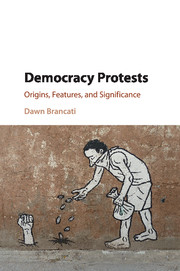Book contents
- Frontmatter
- Dedication
- Contents
- List of Figures
- List of Tables
- Acknowledgments
- 1 Introduction
- 2 Characteristics of Democracy Protests
- 3 Relating Economic Crises to Democracy
- 4 Analyzing the Rise of Democracy Protests
- 5 Analyzing Elections as Trigger Events
- 6 Historical Trends in Government Responses
- 7 Analyzing Political Accommodation
- 8 Historical Trends in Democratization
- 9 Analyzing Democratization
- 10 Conclusion
- Appendix: Data and Measures
- References
- Index
Appendix: Data and Measures
Published online by Cambridge University Press: 05 September 2016
- Frontmatter
- Dedication
- Contents
- List of Figures
- List of Tables
- Acknowledgments
- 1 Introduction
- 2 Characteristics of Democracy Protests
- 3 Relating Economic Crises to Democracy
- 4 Analyzing the Rise of Democracy Protests
- 5 Analyzing Elections as Trigger Events
- 6 Historical Trends in Government Responses
- 7 Analyzing Political Accommodation
- 8 Historical Trends in Democratization
- 9 Analyzing Democratization
- 10 Conclusion
- Appendix: Data and Measures
- References
- Index
Summary
Protest Characteristics
Democracy Protest: occurrence of a democracy protest in a year, coded 1 if a democracy protest took place in a year, and 0 otherwise. (See Chapter 1, Section 1.1 for the definition of a democracy protest.)
Borderline Democracy Protest: borderline democracy protest, coded 1 if there is some ambiguity as to whether a protest meets the definition and coding criteria of a democracy protest, and 0 otherwise. Typically, this ambiguity pertains to the extent to which open and competitive elections constitute the primary demand of the protest.
Election-related Democracy Protest: election-related democracy protest, coded 1 if a democracy protest occurred in relation to a particular national election, and 0 otherwise. Demands of these protests include: reforms ahead of an election to reduce the potential for fraud or to make an election more open and competitive, the postponement of an election for the same reasons, as well as measures to rectify electoral fraud after an election, such as a recount or a new election, and so forth.
Participants (number): number of participants at the single largest rally of a given democracy protest, coded as follows: 0 = no protest; 1 ≤ 1,000; 2 = 1,000–10,000; 3 = 10,000–100,000; 4 = 100,000–1 million; and 5 = 1 million or more. Where the unit of analysis is the protest, the “no protest” category is omitted, and where the dependent variable is either “political concession” or “executive deposition,” the values for this variable are based on the time prior to either event.
Participants (per capita): number of participants per capita present at the single largest rally of a given democracy protest. It is calculated as the estimated number of participants at the single largest rally divided by the national population in the previous year (see Demographics below for population data). Where the unit of analysis is the country-year, this variable is coded 0 if a democracy protest did not occur in a year, and where the dependent variable is either “political concession” or “executive deposition,” the values for this variable are based on the time prior to either event.
Information
- Type
- Chapter
- Information
- Democracy ProtestsOrigins, Features, and Significance, pp. 182 - 192Publisher: Cambridge University PressPrint publication year: 2016
